
by bungalow101 | Jun 14, 2023 | INSIDE, Other areas
BASIC DESIGN FOR A CRAFTSMAN HOUSE INTERIOR
 What is interior design? It is a combination of art, science & technology that is employed to enhance the quality of our lives. It is also about understanding how people operate in a space in order to make it functional. In this article, we’re going to look at the elements of basic design for a Craftsman house interior
What is interior design? It is a combination of art, science & technology that is employed to enhance the quality of our lives. It is also about understanding how people operate in a space in order to make it functional. In this article, we’re going to look at the elements of basic design for a Craftsman house interior
When you’re talking about interior design in a bungalow, you must add history & philosophy, & you must also consider the science of that time as well as the technology & the materials that were available then. For example, the main parts of a house are built with wood- both structural & decorative. The wood available at that time was from old-growth forests. These were decimated over a century ago.
However, though times have changed, basic design theory has not. Let’s go through the basics, starting with the 8 elements, the word element being defined by Oxford as, “a part or aspect of something abstract, especially one that is essential or characteristic.” Example: “The death had all the elements of a great tabloid story.”
So let’s take a look at the parts/basics/rudiments of creating visual harmony- space, line, form (shape), pattern, light, texture, scale & color- to see how they relate to the Arts & Crafts Movement & how to apply them to your bungalow. Then we’ll trot through the principles of design in which you will combine these elements to create a home that pleases you, suits your needs & is within your budget.
USE OF SPACE IN BUNGALOW INTERIOR DESIGN
When we’re talking about space in interior design, we’re not referring to Buzz Lightyear, nor Howard Wolowitz, the creepy astronaut from Big Bang theory. Space, as applied to creating visual harmony in interiors is a 3 dimensional concept- simply the length, breadth & height of the room.
There are 2 types of space we must consider in our planning.
Negative Space
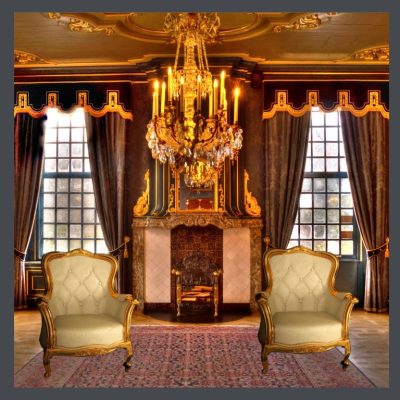 Negative space is the area around & between objects, what we usually think of when we say space. It allows our eyes to pause & to see objects individually. With the use of negative space, the eye gets a rest.
Negative space is the area around & between objects, what we usually think of when we say space. It allows our eyes to pause & to see objects individually. With the use of negative space, the eye gets a rest.
When you look at Victorian room, you see little negative space. You are assaulted by color on color, pattern on pattern. The Industrial Age made this aesthetic possible with its introduction of mass production. Whereas it may have taken weeks or months to manufacture a single chair by hand, with machines, 100s of chairs could be cranked out in a single day. Ditto for textiles- draperies, rugs, pillows. Add accessory pieces to that & you get a highly ornate room, with no negative space. Even the windows are topped with valences, then heavy ceiling to floor curtains hang down in complex patterns, & are tied back with big, fluffy tassels.
Looking up, the ceiling features a gilded center medallion & multiple moldings. Following downward we may see perhaps 3 more ornate patterns & a fireplace with more curlicue carved moldings before our eyes drop to an oriental rug featuring still more colors & designs. And plopped on the rug is an abundance of furniture, again carved & again gilded.
Whew!
LESS IS MORE WHEN DESIGNING A BUNGALOW
Enter the Arts & Crafts era, with its protest against the excesses of Victorian design coupled with its elevation of craftsmanship. If you haven’t read the Introduction, take a moment now to do so because in the article there, AN ARGUMENT FOR SIMPLICITY IN HOUSEHOLD FURNISHINGS written in 1901 by one of the foremost influencers of the time, explains the aesthetic beautifully.
The founders of A&C Movement revered nature. When you get that uncomfortable feeling that you need some space, you head outdoors to open vistas & soaring skies- the peace & serenity of negative space. In Arts & Crafts design, each object gets its own space. Perhaps an object is part of a vignette, but individual groupings are displayed respectfully giving each one importance.
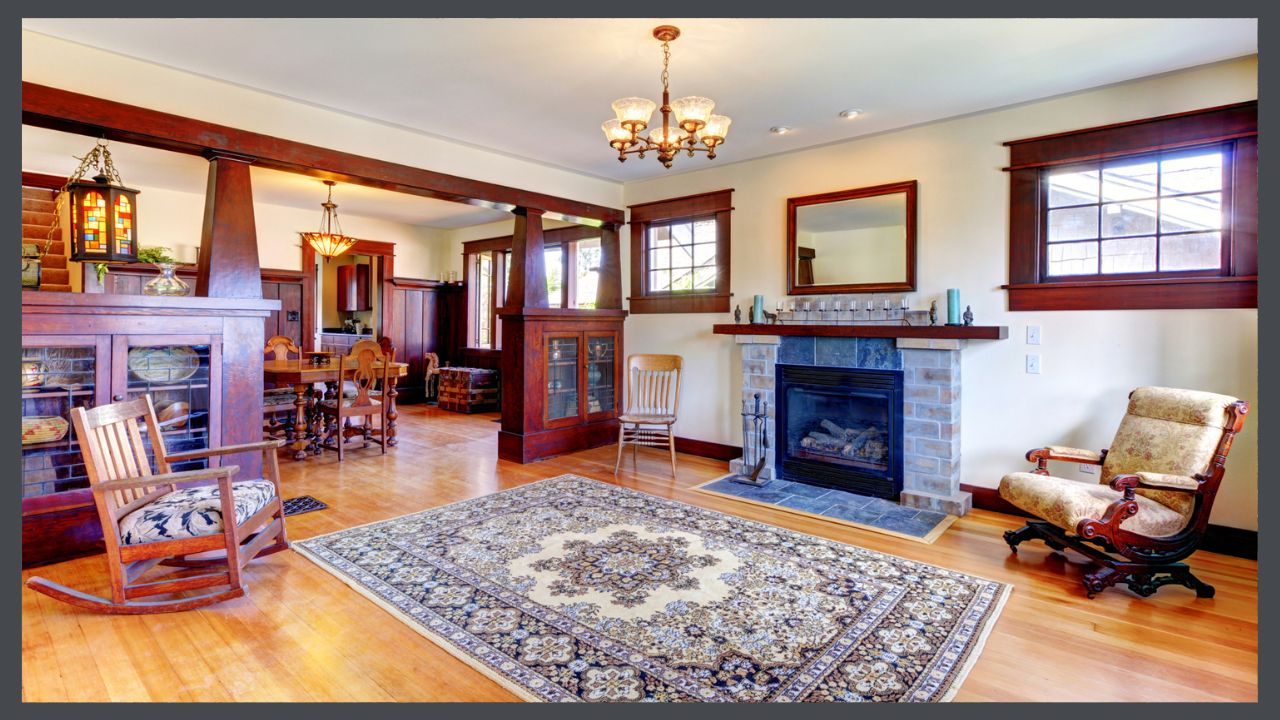
Prior to the Industrial Age other than for the very wealthy, minimalism was a necessity born of scarcity. With the Movement, especially in America with the influence of Stickley, interiors once again became simple & uncluttered. Negative space.
My mother taught me this concept when I was but a wee one. She pointed out to me a piece of jewelry sitting alone in a glass case in a museum. She explained that giving the piece space around it forced you to consider it alone & distinctly communicated its grandeur & high value.
Positive Space
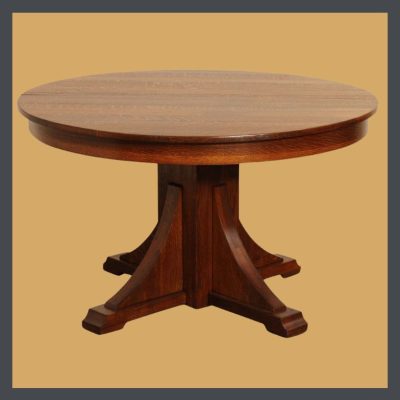 Positive space is the areas defined by objects- architectural details, furniture, textiles, artwork, lighting. The areas are where you want to direct the eye. Which objects you choose & how you place them will determine how the space will feel. Here you can employ all the rest of the elements- form, color, light & texture- to create a mood, tell your story, & enhance the existing features of your bungalow, as well as creating a space that will serve you & your family well.
Positive space is the areas defined by objects- architectural details, furniture, textiles, artwork, lighting. The areas are where you want to direct the eye. Which objects you choose & how you place them will determine how the space will feel. Here you can employ all the rest of the elements- form, color, light & texture- to create a mood, tell your story, & enhance the existing features of your bungalow, as well as creating a space that will serve you & your family well.
The well-know statement here by William Morris, “Have nothing in your house that you do not know to be beautiful or believe to be useful,” is a good guide here in creating a visually pleasing positive space. Should you not have the funds to buy beautiful things, please do not be tempted to buy objects to just fill that space. Rattle around in it until you are lucky or clever enough to acquire things that you truly love.
 Using the correct balance of positive & negative space will help you achieve the look that you want. Like the yin & yang of ancient Chinese philosophy, positive & negative spaces are opposite but complement or complete one another & interrelate to form a whole.
Using the correct balance of positive & negative space will help you achieve the look that you want. Like the yin & yang of ancient Chinese philosophy, positive & negative spaces are opposite but complement or complete one another & interrelate to form a whole.
An empty room is nonfunctional unless you like to sitting on the floor. It echoes & feels a bit lifeless & depressing. You instinctively want to add something to it!
A cluttered room is often just as nonfunctional. Just watch an episode of Hoarders! It is difficult to keep clean & orderly & your first instinct is to think about getting rid of some of the excess.
Well, it’s my reaction anyway!
THE IMPORTANCE OF LIGHT IN A BUNGALOW INTERIOR
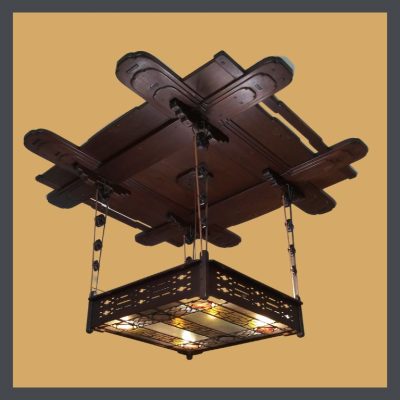 Light is a vital aspect of any space. A key characteristic of bungalows is that they tend to be on the dark side. Their shady porches & deep overhangs made them bearable before air-conditioning & their dark wood can feel oppressive prompting people to pull out the paintbrush. (Put it down, please.) Once against, contrast creates interest here & the correct use of color & lighting will make your house more livable & lovely.
Light is a vital aspect of any space. A key characteristic of bungalows is that they tend to be on the dark side. Their shady porches & deep overhangs made them bearable before air-conditioning & their dark wood can feel oppressive prompting people to pull out the paintbrush. (Put it down, please.) Once against, contrast creates interest here & the correct use of color & lighting will make your house more livable & lovely.
If you want to learn more about lighting, please visit my illuminating series of articles that cover this subject.
Even without a spectacular feature by Greene & Greene!
You can read more about Arts& Crafts lighting here.
In Part 3 we’ll take a look at some of the other elements of interior design & consider how they relate to the enhancement & enjoyment of your bungalow!
 STAY IN THE BUNGALOW KNOW!!!
STAY IN THE BUNGALOW KNOW!!!
Sign up for our newsletter & receive our FREE E-book, 7 VITAL Things to Do Before You Hire a Contractor.

by bungalow101 | Jun 13, 2023 | Other areas
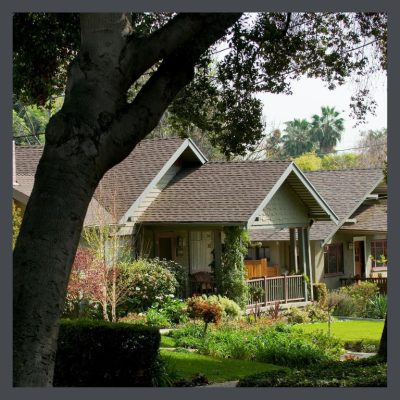 INTERIOR DESIGN FOR A CRAFTSMAN HOUSE -More Elements
INTERIOR DESIGN FOR A CRAFTSMAN HOUSE -More Elements
One of the things that I love the most about the interiors of A&C homes is that though similar, each one is made distinct by the choices made in playing various design elements, one with another. Visiting the homes of Bungalow Heaven on its annual tour is a great example of this. The houses, one to the next are highly distinct, while their similarities contribute to the allover character of the neighborhood. These elements are all crucial in planning the interior design for a Craftsman house- its functionality & its charm.
So let’s continue our look at the parts/basics/rudiments of creating visual harmony, a continuation of those elements from Part 2., & how they relate to your bungalow. Differing uses of each design element make each interior wholly itself & part of the fun is in identifying those unique bits.
USE OF LINES IN INTERIOR DESIGN FOR A CRAFTSMAN HOUSE
Lines help to delineate the space in a room & guide the eye. Using lines, you can change the perceived space of a room, you can direct attention to your focal point & tell a visual story by directing attention.
Horizontal lines give a sense of solidity, stability & efficiency. You do not have to look far in the Arts & Crafts Movement to see horizontal lines. The work of Frank Lloyd Wright, the Greene Brothers & Stickley all emphasize the horizontal, expressing a turning away from the frivolity of the previous era. Our bungalows exteriors are defined by their low, horizontal shapes.
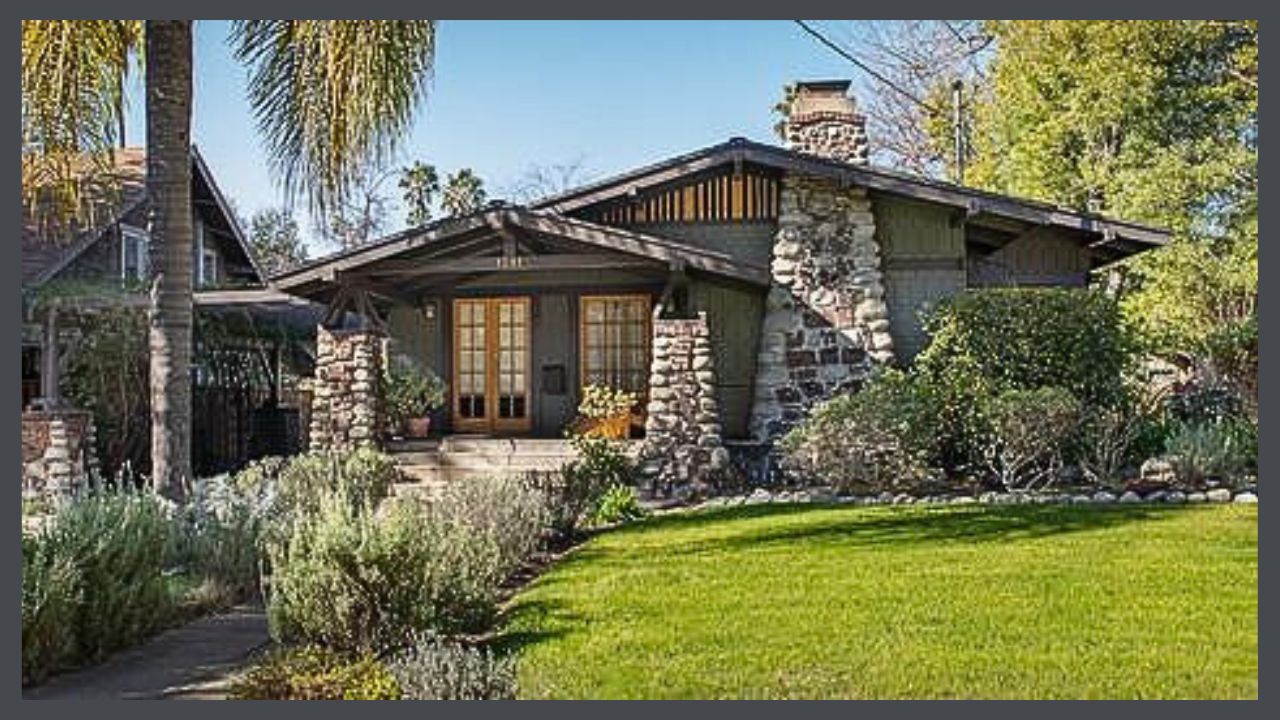
Vertical lines inspire a sense of freedom & strength- think churches of all periods.
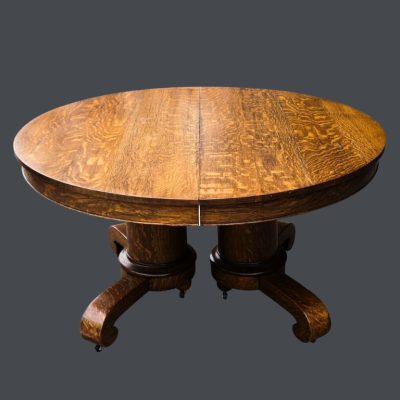 Dynamic lines create a feeling of energy & movement. These lines are found most often in the arts & crafts of the Movement, in the portrayal of nature. Pottery, textiles & metalwork feature provide a flowing contrast to the often bulky feel of furniture typical to the period. The juxtaposition of these elements with the horizontal lines of the furniture create interest in a room.
Dynamic lines create a feeling of energy & movement. These lines are found most often in the arts & crafts of the Movement, in the portrayal of nature. Pottery, textiles & metalwork feature provide a flowing contrast to the often bulky feel of furniture typical to the period. The juxtaposition of these elements with the horizontal lines of the furniture create interest in a room.
Another place that you find dynamic lines is in the wood grain of the furniture, the flooring & the built-ins. Quartersawn, or Tiger Oak is used heavily in Craftsman furniture, creating its own subtle, dynamic flow of life within the pieces themselves. The graining of the beautiful flooring of Tiger Oak, Douglas Fir or Maple add more of the natural world to the home & several woods, each with their own dynamic grain lines, are often mixed in a house, with flooring of one species, & built-ins of yet another or others.
THE ELEMENT OF FORM IN BUNGALOW DESIGN
Form, a 3-dimensional geometric figure (a cube, a sphere, a cylinder or cone, etc.) as opposed to a shape (a square, a circle, a triangle, etc.) which is 2 dimensional, refers to the shape of the room & any of the objects within it. Shapes are considered to be either geometric, which create a sense of order & structure, or natural/organic which provide movement & fluidity. In the A & C house, we tend to see many geometric forms, in the shapes of the rooms themselves, the furniture, the fireplace, built-ins, the windows & doors. The organic forms of cushions, pottery, pillows, the draping of the window treatments, even the logs in the fireplace create an interesting counterpoint to the geometric objects which ground the space.
USE OF PATTERN IN THE PLANNING OF INTERIOR DESIGN FOR A CRAFTSMAN HOUSE
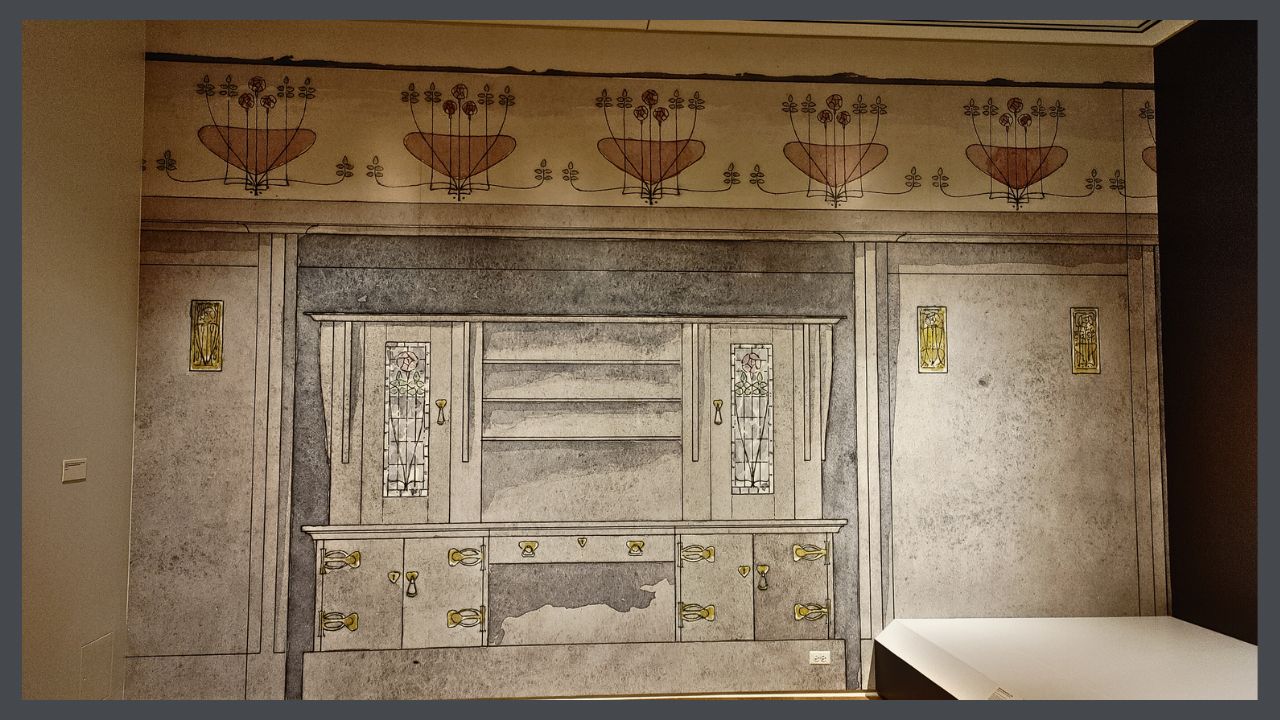
A pattern is a repeating (of shape, line or color) design. Think wallpaper or stencils.
Inspired by nature, the American Arts & Crafts Movement looks very different from that of the earlier, European aesthetic. William Morris was inspired by flowers, while Stickley was a great fan of the log cabin. Each of them based their concept of beauty on the natural world, but their interpretations are hugely dissimilar.
This cabinet rendering above, by Charles Rennie Mackintosh, shows how powerful a pattern can be as it sweeps the eye across the expanse of the entire wall.
THE USE OF TEXTURE IN CRAFTSMAN STYLE
 A home is an intimate space & tactile sensation, interpreted through the skin & the eyes is a key element in design.
A home is an intimate space & tactile sensation, interpreted through the skin & the eyes is a key element in design.
Visually, texture helps give a space dimension. Tactiley, it provides comfort or utility.
I love the look & feel of plaster walls with its soft look & imperfections. To me, textureless, flat drywall is hard & cold, machine made & cheap. I love how a wood floor feels under my feet. Linoleum has that nice hint of resilience & on a cold, winter morning, I’m happy to have a rug under my toesies.
Nubby linen curtains over built-in bookcases, flanking a tile fireplace. Smooth pottery with its soft matte glaze complimenting the heavily figured oak mantel. And kitty, playing with her toy on a rug. The natural materials of the Movement- wood, clay & fur, display their textures honestly.
USING COLOR IN YOUR BUNGALOW
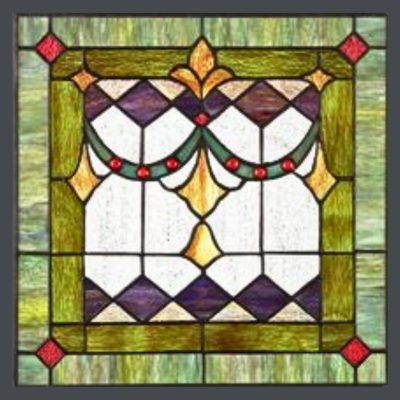 Colors are very powerful in setting tone & influencing mood in the interior design for a Craftsman house. You spend a great deal of time in your home & I think that you might need to review Part 1. THE FIRST VITAL STEPS, in which you considered your needs & wants for your home. Color choices for an invigorating home will be different from those of a home in which you are seeking peace & comfort. For example, the warm colors- red, yellow, orange- are going to stir the blood & are associated with passion. The cool colors are known to lower blood pressure & be calming & soothing. Both of these palettes are appropriate in an bungalow.
Colors are very powerful in setting tone & influencing mood in the interior design for a Craftsman house. You spend a great deal of time in your home & I think that you might need to review Part 1. THE FIRST VITAL STEPS, in which you considered your needs & wants for your home. Color choices for an invigorating home will be different from those of a home in which you are seeking peace & comfort. For example, the warm colors- red, yellow, orange- are going to stir the blood & are associated with passion. The cool colors are known to lower blood pressure & be calming & soothing. Both of these palettes are appropriate in an bungalow.
The subject of color is well covered in my PAINT series. I suggest that you read the complete series to get a full handle on general color theory A&C color in particular. Because the major paint manufacturers have provided us with historic palettes, many people have the idea that these are the only choices. They are so-o-o-o not.
Take a look at my Pinterest page which shows many fine examples of colors for the interior of your home.
Next, in Part 4., we are going to look at the principles of design- the guidelines for combining these elements when you are creating interior design for a Craftsman house

STAY IN THE BUNGALOW KNOW!!!
Sign up for our newsletter & receive our FREE E-book, 7 VITAL Things to Do Before You Hire a Contractor.
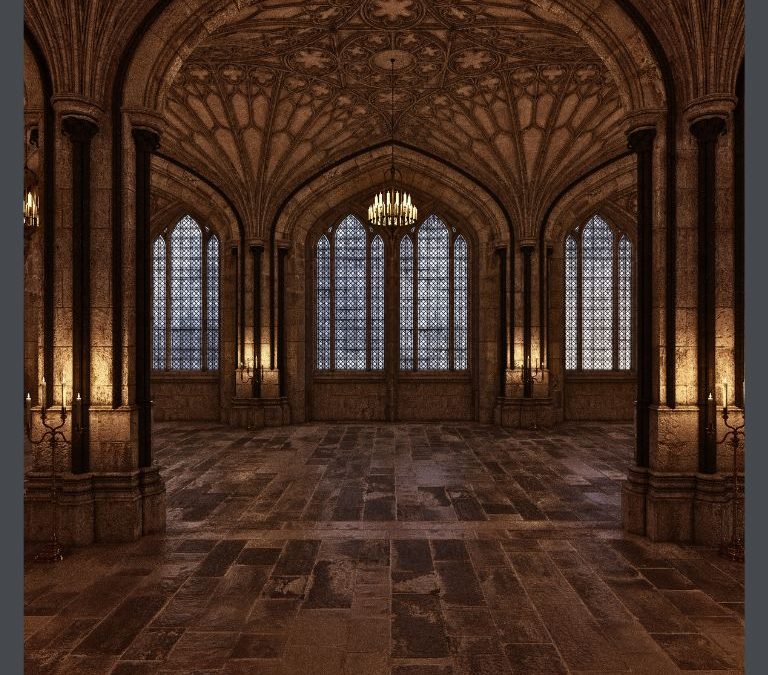
by bungalow101 | Jun 12, 2023 | INSIDE, Other areas
HOW TO DECORATE IN THE CRAFTSMAN STYLE
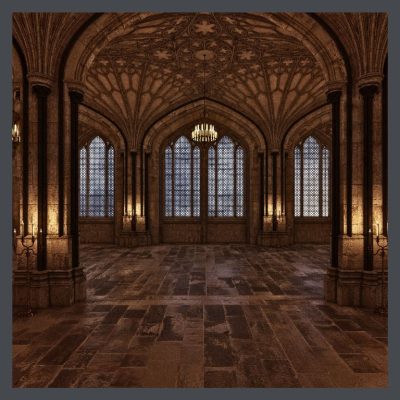 My art training consisted of growing up in museums, exposing me to beautiful objects, exquisitely displayed, ballet with its delightful costumery & stage sets, the arts & crafts of the native Americans of the southwest, & the example set by my mother, who had impeccable taste. From a young age, I appreciated beauty but I never had an aptitude for drawing or painting so I never studied art. My taste was formed by what I saw & what my mother taught me. I grew up learning how to decorate in Craftsman style just by osmosis & later, my bungalows were much admired, with 2 of them being featured in books & magazines & on home tours.
My art training consisted of growing up in museums, exposing me to beautiful objects, exquisitely displayed, ballet with its delightful costumery & stage sets, the arts & crafts of the native Americans of the southwest, & the example set by my mother, who had impeccable taste. From a young age, I appreciated beauty but I never had an aptitude for drawing or painting so I never studied art. My taste was formed by what I saw & what my mother taught me. I grew up learning how to decorate in Craftsman style just by osmosis & later, my bungalows were much admired, with 2 of them being featured in books & magazines & on home tours.
Until just a few years ago, I had never studied design or color theory. To be honest, I had the idea that it was a bunch of arbitrary ideas, made up by academics & had no application in real life. Then, away from home, taking care of my mother when my brother was ill, I had some time on my hands & decided to study design theory. What I discovered is that it is actually a body of data based on observation & application. It does have something to do with me! This information validated my natural/environmental aptitude & also taught me much about creating beauty & harmony that I could actually use to help people decorate their Craftsman homes.
We have come to the first lesson about the principles, or basic rules, of creating visual harmony in design. In the INTRODUCTION, we heard from Gustav Stickley who brought the Arts & Crafts Movement to our country from Europe, endowing it with a distinctly American voice. Part 1 is the the soul-searching session, formulated to help you determine what your lifestyle needs & aesthetic preferences are. Parts 2 & 3 break down interior design into its component parts as expressed in the Movement & as you can apply them to your own bungalow. These elements are the puzzle pieces of design & the way that you fit them together, to decorate in the Craftsman style, is found in the principles.
PRINCIPLES OF INTERIOR DESIGN AS APPLIED TO YOUR BUNGALOW
There are 7 principles of interior design: unity, balance, rhythm, emphasis, scale & proportion, contrast, & details, which apply to any home or even to commercial spaces. How do these basics apply to how to decorate in the Craftsman style?
In order to properly familiarize yourself with the decor most complementary to your home, it is important to understand the aesthetic that inspired every aspect of your home’s architecture. Please watch these videos on the Arts & Crafts Movement which will allow you to see many examples & learn the history of your home’s charming character. Following these principles will help you enhance the features that give it its character & help you create a home that is harmonious, gracious & comfortable.
UNITY/INTEGRATION
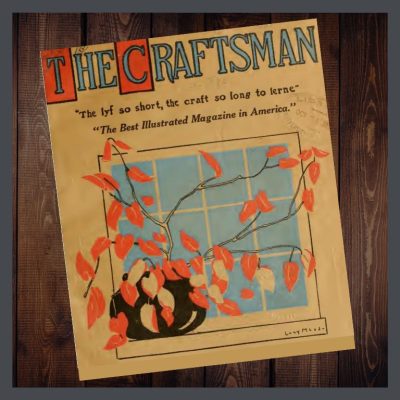 These words of Irene Sergent, in the Craftsman magazine, express the unifying message, the unifying theme, of the American Arts & Crafts Movement in interior design,
These words of Irene Sergent, in the Craftsman magazine, express the unifying message, the unifying theme, of the American Arts & Crafts Movement in interior design,
“We are, first of all, met by plain shapes which not only declare, but emphasize their purpose. Our eyes rest on materials which, gathered from the forests, along the streams, and from other sources familiar to us, are, for that reason, interesting and eloquent.”
It is not imperative that you spend hundreds of thousands of dollars buying antiques to decorate in Craftsman style. Stickley himself strove to produce his wares for the masses. But, your bungalow has a visual message of its own & through your furniture & decor, color, texture & shape choices, you can amplify this message.
USING SCALE & PROPORTION TO DECORATE IN THE CRAFTSMAN STYLE
Scale is defined as how an element relates to the size of the room it occupies.
Proportion has to do with the way an element relates to other things in the room.
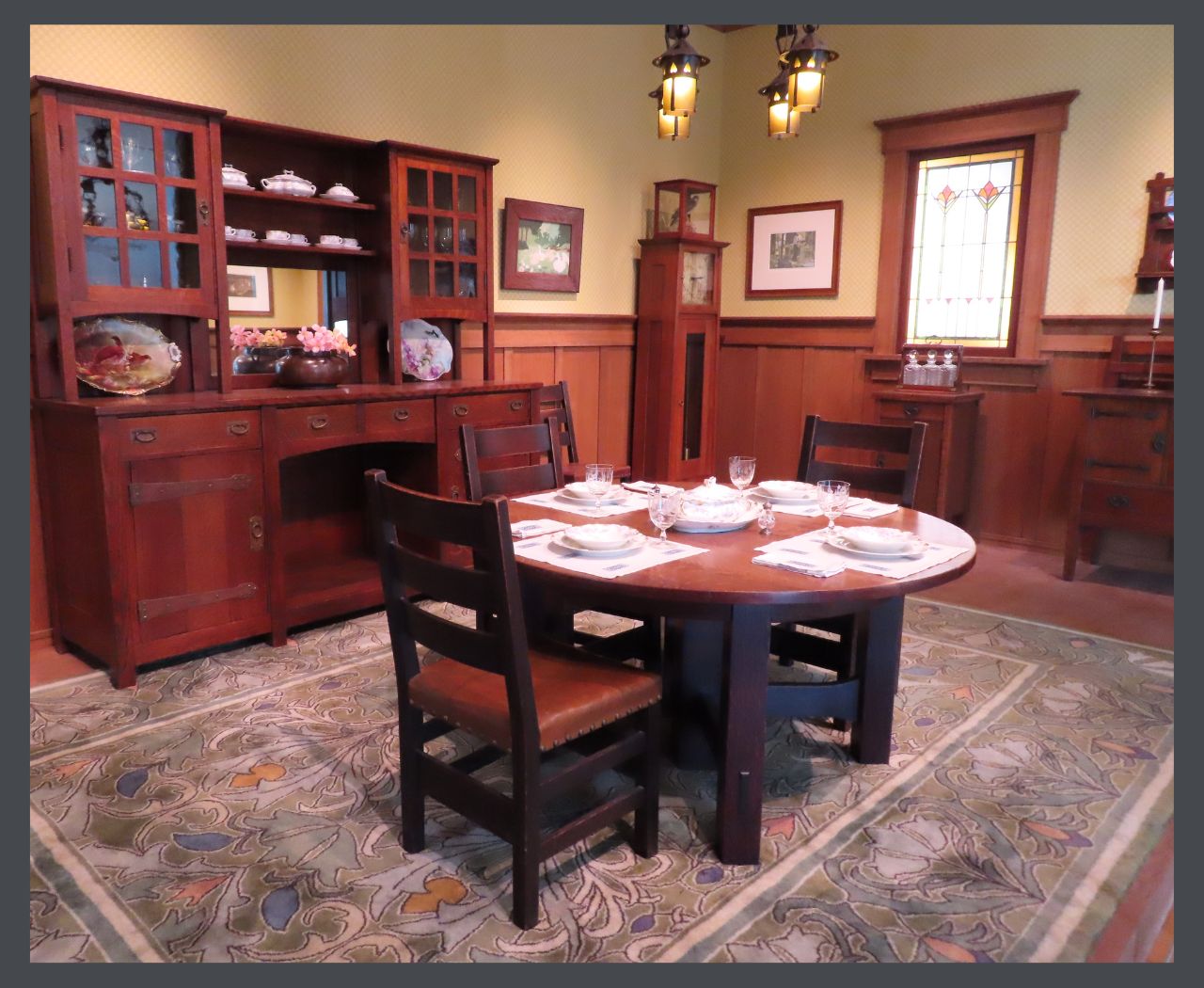
The proportions of this large Stickley dining room are appropriate. Even the pattern on the rug is large as are the pottery & metalwork displayed on the sideboard. This is a great example of how to decorate in the Craftsman style.
I have seen this concept to be tricky in a small bungalow. A petite space requires petite scale furniture, but using a smaller number of medium pieces can also be of benefit. Remember our negative space from Part 2? The key is to maintain enough negative space that each item can be admired easily & you don’t feel like there’s no room for you.
I have a friend who downsized & brought all her more petite pieces with her. And I do mean all. Each object is beautiful & the correct scale for the new condo, but the whole room is just too crowded. There’s no empty space to catch your breath. When I visit her, after navigating my way carefully to the couch, I am distracted from our conversation by my compulsion to silently choose which pieces she should discard!
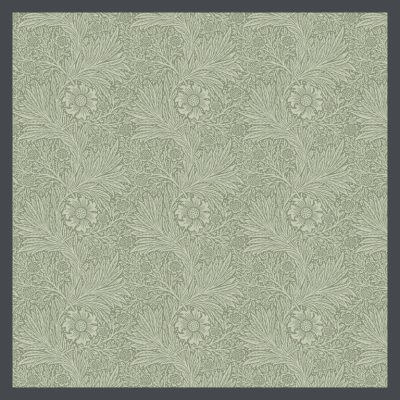 I’m a fan of textiles & encourage the use of simple or low contrast patterns in a smaller bungalow, or room. The Arts & Crafts palette tends to be more muted so it’s a good choice for a house with a reduced square footage, but I still recommend using a more restrained hand in a mini-bungalow. This William Morris pattern, with its muted, pale colors will create a feeling of softness rather than harshly stopping the eye, & would be a good addition to the decor of a smaller space.
I’m a fan of textiles & encourage the use of simple or low contrast patterns in a smaller bungalow, or room. The Arts & Crafts palette tends to be more muted so it’s a good choice for a house with a reduced square footage, but I still recommend using a more restrained hand in a mini-bungalow. This William Morris pattern, with its muted, pale colors will create a feeling of softness rather than harshly stopping the eye, & would be a good addition to the decor of a smaller space.
In a less expansive room, I’d be inclined to forgo the wallpaper, but a long, frieze (a sculptured or otherwise ornamented band on a wall, near the ceiling) can create space. This lovely one was produced by Grueby Faience of Boston in 1904. Made of glazed earthenware, it would surely draw the eye horizontally, visually lengthening the wall. The term faience was used to describe earthenware with relief molding, which was then decorated with colored glazes. Grueby made a large variety of tiles & pottery in this style.

The repeating pattern keeps the eye moving along, creating visual space. You can create the same effect with a stenciled pattern & learn a new art form too! There are many wonderful A&C stencil patterns that you can find here.
In any size home, you want to make sure that your items are approximate in their sizes. A dinky table with a huge sofa is going to get lost. However, grouping smaller, complimenting items to form a vignette can create balance. This photo of a Gamble House bedroom shows all of the pieces to be in proportion to all the others, from the beds, to the desk to the ceiling fixture.
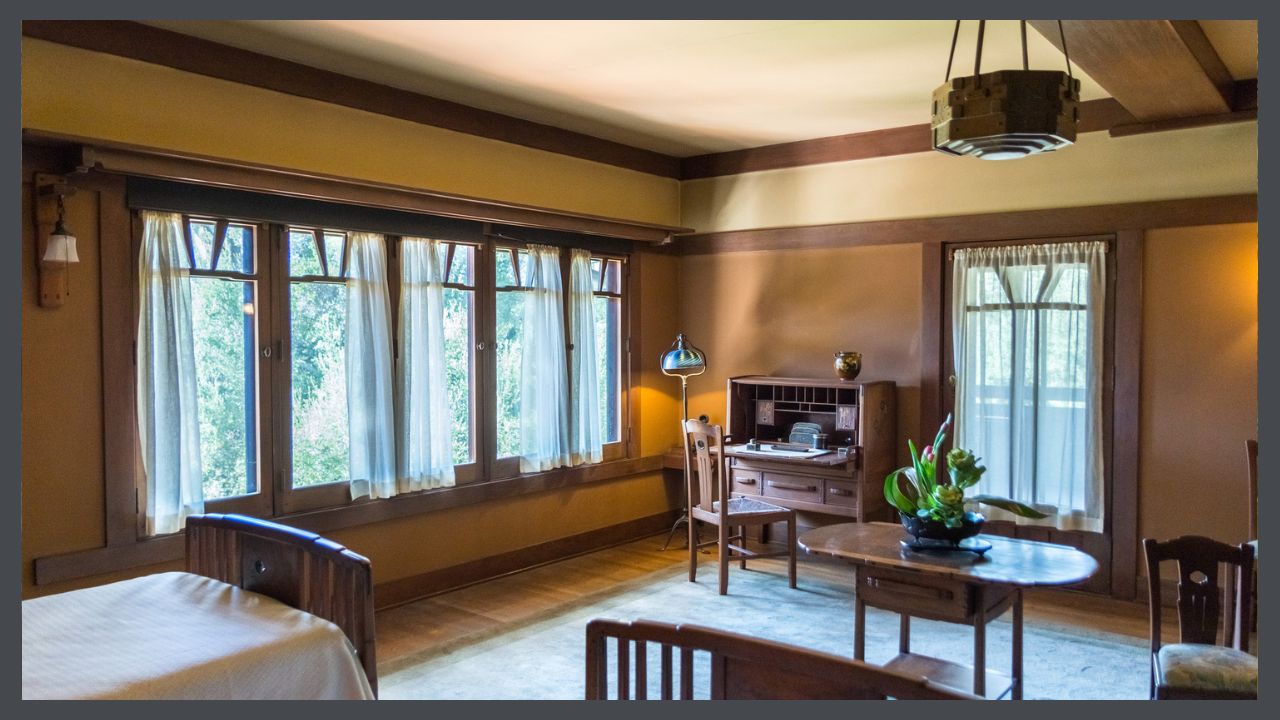
I am a big believer in using family heirlooms & sometimes you will find that your grandmother’s China cabinet, or your favorite whatever is just too big for the room. I encourage you to figure it out. I moved my cherished 100 year old Chinese kitchen cabinet (With its carved cloud lift motif, it is very Greene & Greene!) around my new house for days after downsizing 400+ square feet. In desperation I angled it on 2 walls, added ornamentation on the top, flopped an obi over it that hangs down about 4 feet on each side, & a piece of a camel bridle (believe it or not!) to draw the eye vertically. This shrank the cabinet horizontally & now this oversize piece works visually in my undersize dining room even though you have to scoot around it a tad to walk through the room.
Older houses tend to have higher ceilings. You can take advantage of this by using taller pieces & placing ornamentation on top of them, as I did with my Chinese cabinet.
Just don’t make your living room so dang perfect that it looks like a hotel room or a museum! Make it your own.
Trot on over to Part 5, the almost final decorating article.
 STAY IN THE BUNGALOW KNOW!!!
STAY IN THE BUNGALOW KNOW!!!
Sign up for our newsletter & receive our FREE E-book, 7 VITAL Things to Do Before You Hire a Contractor.
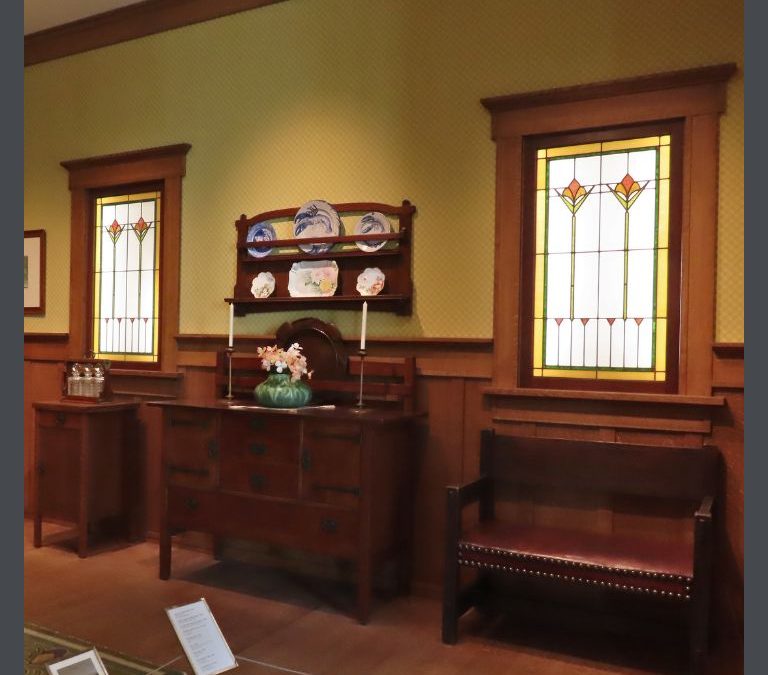
by bungalow101 | Jun 10, 2023 | Other areas
MORE ON BUNGALOW STYLE INTERIOR DESIGN
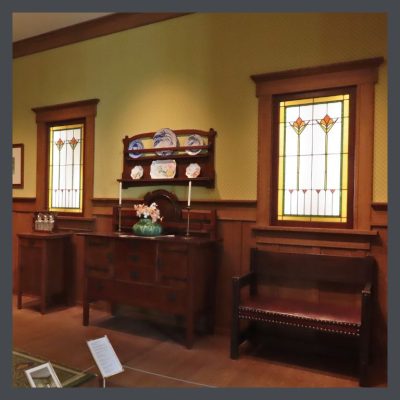 We have come to the second lesson about the principles of creating visual harmony in design. The elements of design are the puzzle pieces of design & the way that you fit them together, to decorate in the Craftsman style, is found in the principles. These bungalow style interior design tips are the basics of all good design & if applied, will assist you in creating the home that you want. Perhaps you will never have a Stickley dining room like the one at the American Arts & Crafts Museum in St. Petersburg, Florida, but by learning about Arts & Crafts design you will become more confident & satisfied in putting together your home.
We have come to the second lesson about the principles of creating visual harmony in design. The elements of design are the puzzle pieces of design & the way that you fit them together, to decorate in the Craftsman style, is found in the principles. These bungalow style interior design tips are the basics of all good design & if applied, will assist you in creating the home that you want. Perhaps you will never have a Stickley dining room like the one at the American Arts & Crafts Museum in St. Petersburg, Florida, but by learning about Arts & Crafts design you will become more confident & satisfied in putting together your home.
I suggest that you should read the articles leading up to this one. They cover the basic elements of design which you will use in the principles written about here & #4 is about the other principles.
Here is the second half of the 7 principles of interior design: unity, balance, rhythm, emphasis, scale & proportion, contrast, & details, which you can use in any home or even to commercial spaces. Let’s see how you can apply them.
USING BALANCE IN BUNGALOW STYLE INTERIOR DESIGN
 Here we come to the concept of visual weight. Visual weight refers to the degree to which an object draws the eye, which is determined by its size, color and shape. You walk into a room & there’s a mouse & an elephant. Your attention immediately goes to the elephant because of its enormous size. You see 2 squares & one is pale blue & the other bright red. Your attention is instantly on the red. Objects with a regular shape, such as a square or a circle, appear heavier than objects with an irregular shape, such as a paisley, a tear-drop shape with a curled end. The irregularity gives the impression that mass or weight has been removed from a regular shape.
Here we come to the concept of visual weight. Visual weight refers to the degree to which an object draws the eye, which is determined by its size, color and shape. You walk into a room & there’s a mouse & an elephant. Your attention immediately goes to the elephant because of its enormous size. You see 2 squares & one is pale blue & the other bright red. Your attention is instantly on the red. Objects with a regular shape, such as a square or a circle, appear heavier than objects with an irregular shape, such as a paisley, a tear-drop shape with a curled end. The irregularity gives the impression that mass or weight has been removed from a regular shape.
Balance is defined as a condition in which different elements are equal or in the correct proportions & create a feeling of stability. Nobody ever looked at a picture of the Titanic sinking & felt anything but terrible.
There are three ways to achieve visual balance & most homes contain a combination of the different types.
Symmetry
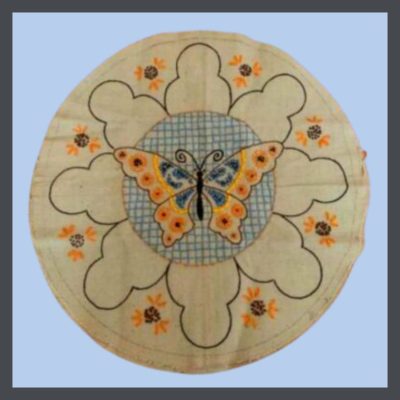 Symmetry is achieved by positioning items evenly along a central axis. It creates a sense of stability, calmness & formality. Mimicking nature- leaves, snowflakes, bodies- this type of balance is often used in A&C design. A good example of this is William Morris’ designs.
Symmetry is achieved by positioning items evenly along a central axis. It creates a sense of stability, calmness & formality. Mimicking nature- leaves, snowflakes, bodies- this type of balance is often used in A&C design. A good example of this is William Morris’ designs.
Symmetry occurs when each side is a mirror of the other, dividing the space into 2 even parts. This is a formal, orderly look & is used often in Arts & Crafts.
Over the decades, life & design have become more casual. At the beginning of the last century, women wore dresses, men wore ties, & formal symmetry was the order of the day. Additionally, the Arts & Crafts Movement, both philosophically & aesthetically, is based on nature, in which there is often great symmetry.
Asymmetry
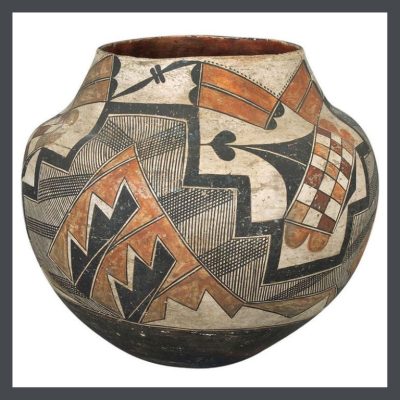 Asymmetry is achieved by positioning an uneven number of things along the central axis. The feeling created by this is more modern, with a greater sense of motion.
Asymmetry is achieved by positioning an uneven number of things along the central axis. The feeling created by this is more modern, with a greater sense of motion.
This native American pot is a wonderful example of asymmetry. Through the use of pattern & color, it creates a visual balance on all sides. Mid-Century is also a good example of the frequent use of asymmetry.
An asymmetrical design is a looser approach. You still strive for visual balance, but without using mirror imagery. Perhaps your couch would be balanced by 2 chairs that would be positioned across from it. Or you might place a large, “heavier” piece of pottery on one side of your mantle & a couple of “lighter” ones on the other.
Radial Balance
Radial balance is formed by placing elements around a circular center core. A dining table with a round fixture, surrounded by chairs is a good example of this. This is is a formal look & often found in Craftsman design.
At the other end of the spectrum is radial balance. This more intricate approach requires establishing a natural focal point and having other smaller pieces diverge from it evenly. A fireplace could be the example of the focal point in question, and then you could carefully arrange other items facing toward it, for example.
RHYTHM
The fetus hears her mother’s heart, the steady pulse of life & once outside the womb, is comforted by lying on her mother’s breast.
Rhythm, a part of every aspect of life, carries us forward in time. In design, it moves the eye from one point to the next, in a pattern of steady repetition, or a sudden change in pattern, creating contrast or focus.
This heard of elephants thunders across the wall in this tile made by Grueby Faience Company in 1900. I have never seen/heard/felt a herd of elephants moving across the plain up close & personal, but I have seen & heard it in films & the rhythm was powerful!

The Arts & Crafts message is one of the natural world, with its gentle (& not so gentle!) rhythm & its subtle variations. This visual rhythm can be created by repeating colors, materials, textures & shapes at varying intervals. Or a frieze of thundering elephants!
The interior features of your house form a basis for this repetition with your wood built-ins & trim. You can provide a contrasting pattern with your textiles, art & other accessories to decorate in the Craftsman style.
HOW TO EMPLOY CONTRAST IN BUNGALOW STYLE INTERIOR DESIGN
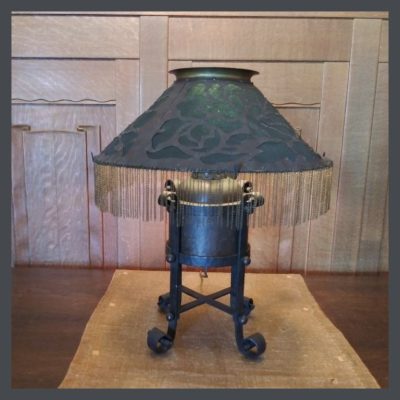 This leads us to contrast, sudden breaks in the rhythm. Linen curtains against the dark of the window frame, pillows on the dark upholstery, creamy slag glass in the lamps on the tables, even the glow of the logs burning in the fireplace, below the dark mantel form a contrast against your dark wood trim.
This leads us to contrast, sudden breaks in the rhythm. Linen curtains against the dark of the window frame, pillows on the dark upholstery, creamy slag glass in the lamps on the tables, even the glow of the logs burning in the fireplace, below the dark mantel form a contrast against your dark wood trim.
The Arts & Crafts aesthetic is on the subtle side, like Mother Nature herself. For example, in this lamp, there are many contrasts, but you have to look for them.
There’s an interesting combination of straight & curved lines that define the piece. In the shade, you see curved, organic cut-outs, but the shade itself is almost a perfect triangle. The straight vertical legs come down into cute little curled feet. Even its shape is rather contradictory. It is both a rolly-poly elf, but is also elongated & moves your eye vertically. The oat colored runner on which it sits provides great contrast to the allover dark appearance of the lamp, as well as the wood wall behind it & the table on which it sits. Then what’s with the fringe on the shade? To me, it is a totally incongruous piece of frou-frou, but it works. I find it charming!
EMPHASIS
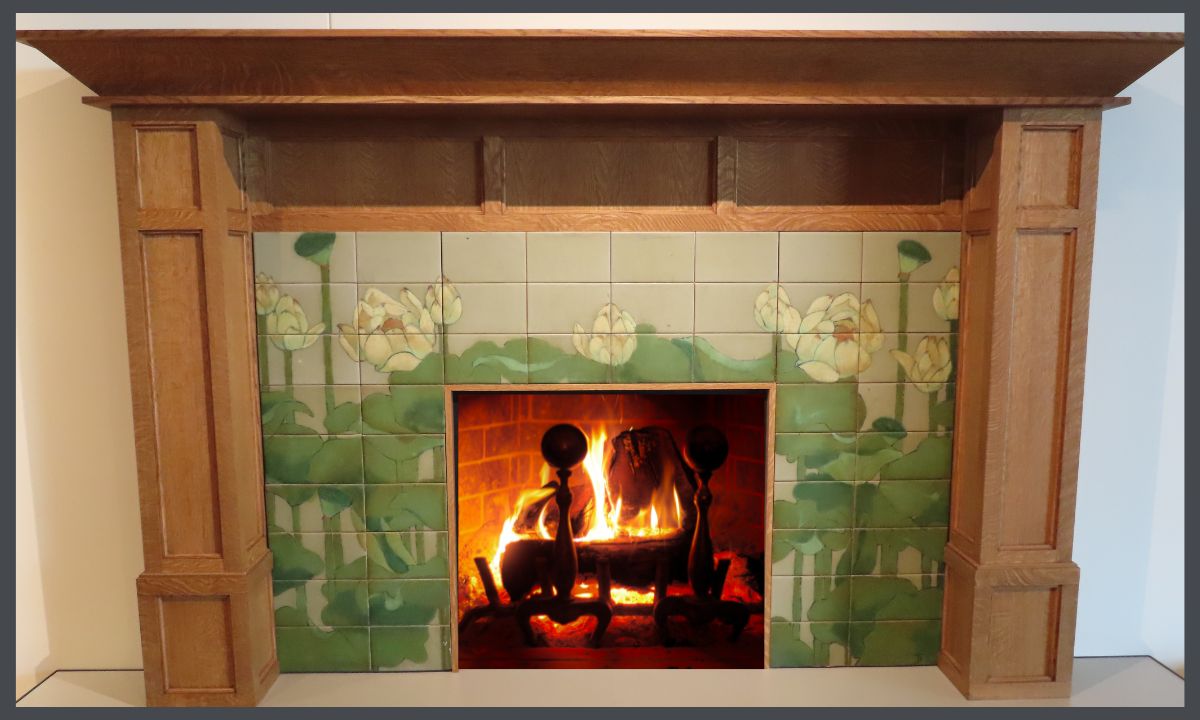
The word is defined by Oxford as “special importance, value, or prominence given to something.”
When you enter a space for the first time, it is the focal point that orients you to all the other elements. This Is where at the eye naturally comes to a halt, & you visually align the whole room to that point. In many bungalows, the focal points are provided by the architecture: your fireplace with its art tile surround, a beautiful built-in sideboard in the dining room, a sweet little inglenook, leaded glass windows. (All features found only in quezillion dollar homes today, by the way!)
Emphasis can be achieved by using line to point at a feature, contrast, negative space, color, light or a change in rhythm. A fireplace like this one would certainly do the trick!
USING DETAIL IN BUNGALOW STYLE INTERIOR DESIGN
While your furniture will help set the tone, it’s the details that will set your bungalow apart. There are so many wonderful choices in textiles, lighting, pottery, metalwork & art that you can fully express yourself while conveying the Arts & Crafts message.
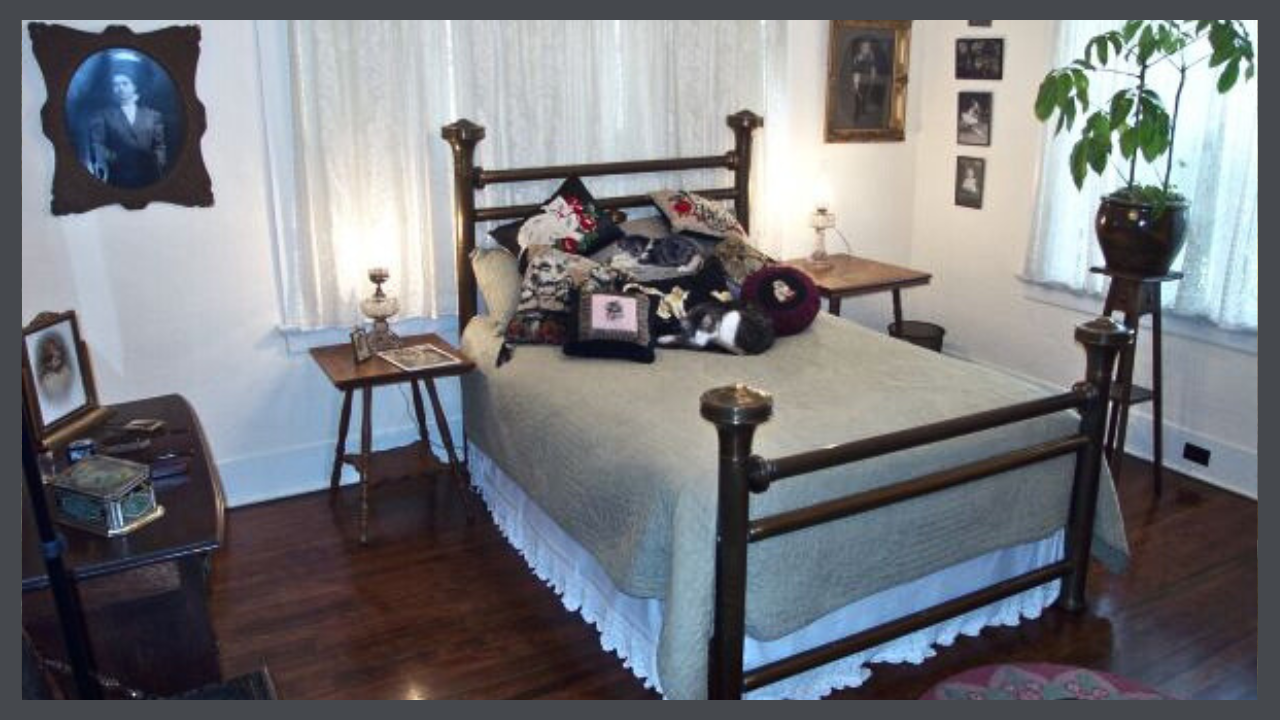
This room in the Hare House, appears in Jane Powell’s book, BUNGALOW: THE ULTIMATE ARTS & CRAFTS HOME despite the fact that yeah, it’s Victorian. However, Linda & I squawked loudly about the fact that not every bungalow buyer trotted out to buy new furniture for their house. It just wasn’t practical. The man who built my house, Reverend Alfred Hare, was known as a good businessman & helped several congregations pay off the mortgages on their church buildings. Throughout the house you see where he chose to spend & where he chose to scrimp. I can guarantee his expenditures did not include new furnishings for the private areas. This argument impressed Jane who was always a sucker for a good backstory & the bedroom appears on Page 238 in all its glory. You can even see the image of my 3 year old mama on the dresser.
So, here, to the left of the bed, you see my grandmother as a young woman. She probably commissioned this portrait with the first money she made as a teacher. One the other side is my husband’s grandfather as a child. I wish the colored, hand-painted background could be seen. On the front wall, photos of my mother-in-law as a child in the 20’s. On my dresser sits my grandmother’s tin candy box which holds her embroidered hankies, & if you look very carefully, you can see her dresser set. The portrait is of my favorite uncle. The lamps beside the bed are oil lamps that my mother had wired for electricity. And on the bed, my kitty pillow collection. Of course the best part of the room is my dear kit, Buhkai, the Big- hearted bungalow kitty. You can read his story here!
As I did, you can express your preferences & tell your story in all of these choices. At the same time, you can honor the history & philosophical underpinnings of your bungalow, the trees who gave their lives for its lumber, the architect who designed it, the craftsman who built it & the people who lived their lives & built your neighborhood & your town, all there, before you were even born.
I’m sure it’s a heck of a story!
Make sure that you begin at the beginning to learn everything you can from this series.
 STAY IN THE BUNGALOW KNOW!!!
STAY IN THE BUNGALOW KNOW!!!
Sign up for our newsletter & receive our FREE E-book, 7 VITAL Things to Do Before You Hire a Contractor.
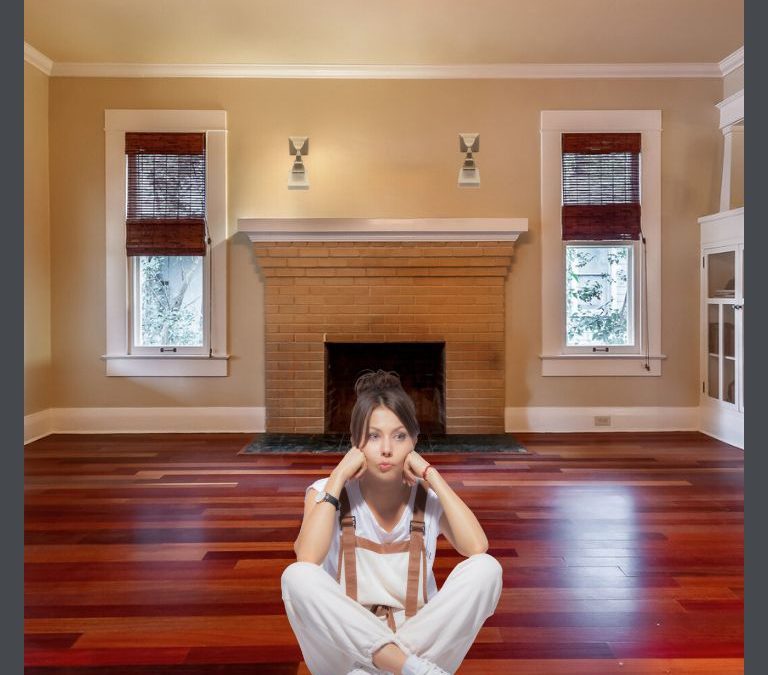
by bungalow101 | Jun 9, 2023 | Other areas
HOW TO DECORATE A BUNGALOW LIVING ROOM/DINING ROOM
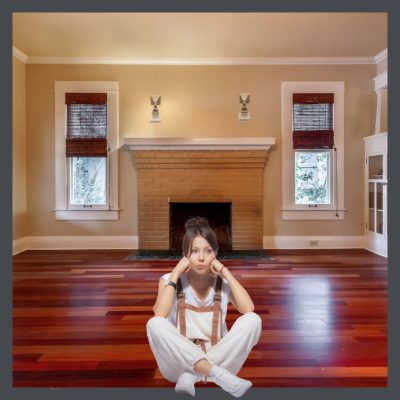 Here you are in your empty house. It echoes. It promises. It suggests. It perplexes.
Here you are in your empty house. It echoes. It promises. It suggests. It perplexes.
In this article, I am going to wrap up all the points of how to decorate a bungalow living room & I will probably add a few, hopefully, wise words of advice too!
This article is written from my own needs as expressed in my responses to the questions in Part 1, as well as my own viewpoint, as expressed in the earlier articles. I am always seeking more knowledge & honor all points of view, so I invite your comments & suggestions. I do request that you honor my pixels.
I’m going to assume that you have read all of the articles in this series. They will form a good reference point as you navigate the panorama of infinite choices. Here’s a review of what each part covers & they will be referenced going forward:
BUNGALOW DON’TS
A handy dandy list of design boo-boo’s to avoid in any style of house with a special focus on bungalows.
DESIGNING YOUR BUNGALOW’S INTERIOR SPACES- an Introduction
The Craftsman Magazine was the arbiter of taste regarding this aesthetic. This post is primarily an article laying out the basic philosophy & design theory of the Craftsman movement, highly applicable when you are looking at how to decorate a bungalow living room.
DESIGNING YOUR BUNGALOW’S INTERIOR SPACES- Part 1
Determining your own needs & message. Looking into your our heart- an exercise. If you have not yet done it, please do so. The decisions that you make here will form pivotal roles going forward.
In this article I have included the wishes of my own heart, which again, will be referenced below.
DESIGNING YOUR BUNGALOW’S INTERIOR SPACES- Part 2
Interior design elements/building blocks: The use of space & lighting in creating beauty, harmony & functionality.
SPACES- Part 3
More pieces of basic design: Types of lines, using different shapes & forms, patterns, textures & color to create a space that you will love.
DESIGNING YOUR BUNGALOW’S INTERIOR SPACES- Parts 4 & 5
Using the principles of design- unity/integration, balance, rhythm, emphasis, scale & proportion, contrast & details to decorate a bungalow living room.
YOUR HANDY-DANDY CHECKLIST FOR HOW TO DECORATE A BUNGALOW LIVING ROOM
When you start doing the steps of furnishing & embellishing, please follow this order because each one builds on the previous ones. I am going to include the numbers of the previous posts so you can see what basic design rules I followed for each one. If you should hang-up on the execution of any one step, take a moment to consider if there are any previous ones that might take more considering or more action.
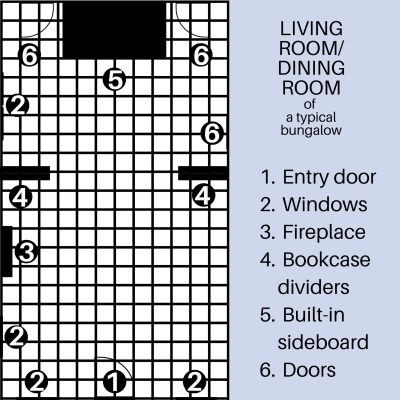 1. Create an overhead scale model of the room or rooms if your bungalow’s dining room is joined to the living room. (Probably.)
1. Create an overhead scale model of the room or rooms if your bungalow’s dining room is joined to the living room. (Probably.)
You can do this on paper or electronically. (I am going to assume that you do not have a design program.) I like to use Canva, a free design program that allows me to do pretty much anything that I need to do. If you do not have a large computer screen, whether or not you have a design, program, I suggest gathering a large pad of grid paper, a ruler, a drafting pencil, an eraser & pair of scissors.
Sketch in the key architectural features of the room- the windows & doors, fireplace, built-ins, wainscoting, chair & plate rails. Here’s my sketch of my 1925 bungalow in Tampa, as an example.
Number each type of fixed element, the existing architectural elements that cannot be changed.You can use the same number for things that are duplicates of the same items.
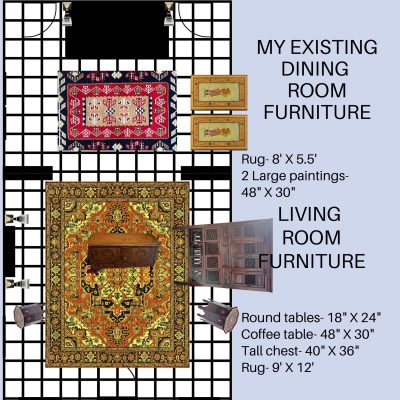 2. Take the measurements of each piece of furniture that will come with you. Include all dimensions & insert them to scale.You can do more than one rendition of this image, fooling around with different pieces. Some of the items that you will bring are not forever pieces. Spaces evolve as you decorate your bungalow.
2. Take the measurements of each piece of furniture that will come with you. Include all dimensions & insert them to scale.You can do more than one rendition of this image, fooling around with different pieces. Some of the items that you will bring are not forever pieces. Spaces evolve as you decorate your bungalow.
When I left the Hare House, I sold many pieces with the house. They had been purchased specifically to make the Hare’s feel welcome & comfortable should they ever decide to pay a call. (Fine, they were dead. I didn’t care.) Other ones didn’t fit my new plan which was to go more ethnic, so that’s what came to Tampa with me, my multi-cultural mash-up of Chinese, Moroccan, & East Indian & my Turkish rugs.
The colors & hand craftsmanship of these cultures fit beautifully with A&C & had heavily influenced the Movement so they seemed right to me. (An Introduction.) I was ready for more color & fortunately, it all worked out in my 1925 bungalow which had a more casual feel than my 1910 Craftsman. (Parts 1 & 2 & 3– wishes & space & lines & color.)
I added them to the grid that I made. These are shown on the diagram, named by type of item. I had some problems to solve here, the main one being the shape of the 2 rooms. Even with the added bookcase dividers (Some bozo had removed the original ones.) it was just too long & thin. There was no division between the 2 spaces. (No open plan for me, thank you!) I used Part 3 for this, deciding on the spaces I wanted to delineate & then using the lines of the rugs to form those areas.
You can clearly see what you are missing by this point! I needed a couch & chairs, a table for under my dining room windows & really needed a dining table & chairs.
I stuck with the symmetrical lay-out of the rooms because A&C just seems to feel symmetrical. I was ready to change it should the new furniture demand it but it did not.
INVESTING IN NEW FURNITURE
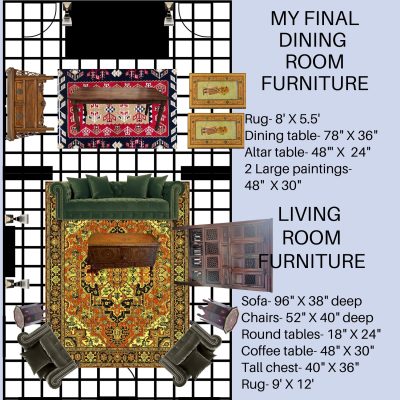 3. So here are the final, fully furnished rooms. It took me a long time to find the perfect couch & chairs because the room was so large & I am never in favor of using a large number of pieces. I needed comfortable ones that were appropriate in the scale of the room, to which I could add my bamboo folding chairs when I was expecting a houseful of people. (Part 1, wishes.)
3. So here are the final, fully furnished rooms. It took me a long time to find the perfect couch & chairs because the room was so large & I am never in favor of using a large number of pieces. I needed comfortable ones that were appropriate in the scale of the room, to which I could add my bamboo folding chairs when I was expecting a houseful of people. (Part 1, wishes.)
I wanted to anchor the room with A&C inspired furniture, not true Craftsman because by 1925, when my house was built, Stickley’s Craftsman style was out of fashion, & considered odd. He had declared bankruptcy in 1915 & his new wares looked more typical 20’s than A&C. I decided to harken back instead of moving forward. The furniture of 1925 was more petite & not suitable in this space which one of my friends described as a bowling alley because someone had ripped out the built-ins. (I built them back.) And even with the dividers it was a lo-o-o-ong space!
The chairs & couch that I chose were large & geometric, using the principles of scale & proportion found in Part 4. They were right for the sizes of the rooms as well as the built-ins that I have designed to be rather chunky. They too served to visually shrink the length of the 2 rooms, with the couch providing a short wall between them.
The principle of unity, mentioned in the same article, was achieved through color & through theme. Even the new pieces like the dining table with its distressed finish, looked old.
SUMMARY
The reason that you are doing all these steps in learning how to decorate a bungalow living room is to accomplish what you learned about your needs & wants in Part 1. You are creating a home that will enhance your life, help you achieve your goals & give you a brighter outlook on daily life. There are few things that are more about you than your living space.
Let me know if you should need some help!
Check out my Pinterest page to see more living rooms.

STAY IN THE BUNGALOW KNOW!!!
Sign up for our newsletter & receive our FREE E-book, 7 VITAL Things to Do Before You Hire a Contractor.
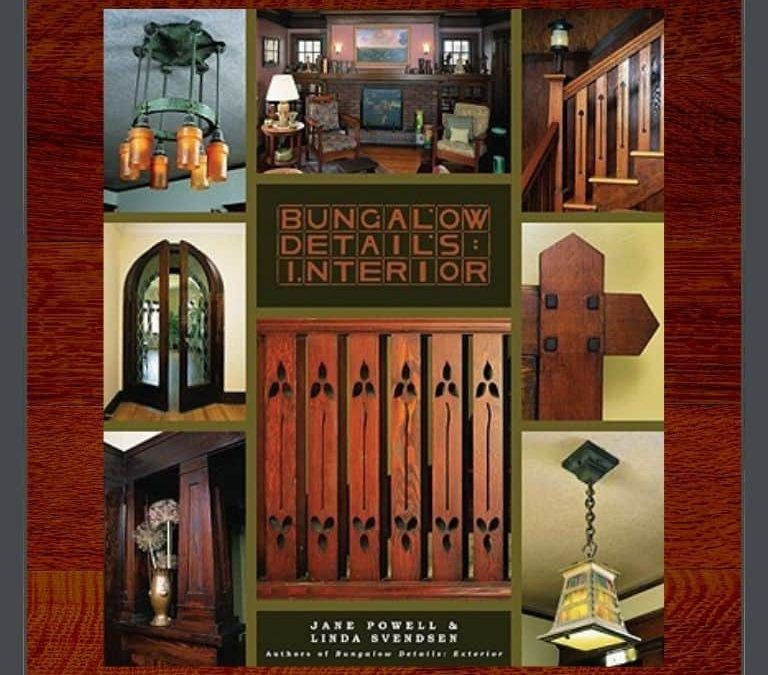
by bungalow101 | Jun 19, 2022 | Other areas
by Jane Powell, author & Linda Svendsen, photographer
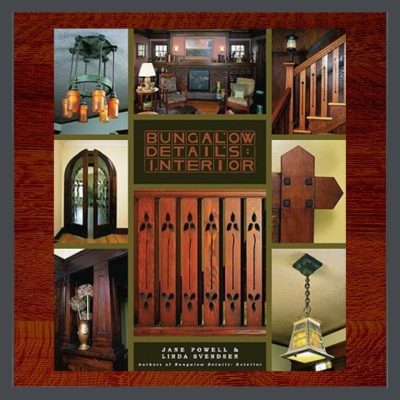 In BUNGALOW DETAILS: INTERIOR, author Jane Powell covers every nook & cranny of America’s favorite house.
In BUNGALOW DETAILS: INTERIOR, author Jane Powell covers every nook & cranny of America’s favorite house.
FOREWARD
“It is the great excellence of a writer to put into his book as much as his book will hold.” – Samuel Johnson
Written 2 years after BUNGALOW: The Ultimate Arts & Crafts Home, this book, though less chunky is still described by Jane as “the longest I have ever written.” The book is crammed with information & text is tiny, but I still recommend giving it a good read. You can rest your eyes by looking at the soothing pictures & occasionally taking a ginger tea break. But, I assure you that after absorbing the contents of this book, you will be an expert, an authority, verily a master on the subject & will be able to amaze your friends with your knowledge. It will also teach you how to live in a bungalow.
As in KITCHENS & BATHROOMS, in every restoration facet she offers compromise solutions.
And, back to the book contents, Jane devotes a whole page to asbestos & strongly recommends testing. I second. Restoring old houses is not for sissies.
CHAPTER ONE: WHAT IS A BUNGALOW?
Here she defines is as a “Know one when you see one kind of things,” but goes on to define it as:
A bungalow is a one-or one-&-a-half story house of simple design& expressed structure, built from local or natural materials, with a low sloping roof, overhanging eaves, & a prominent porch, built during the Arts & Crafts period in America (approximately 1900-1930). But offers the disclaimer, that the definition is pretty broad & you just need to look at enough of them until you know.
Should you be desperate to know now, a check out preservation expert Jo-Anne Peck’s article WHAT THE HECK IS A BUNGALOW, ANYWAY, here.
CHAPTER TWO: ROOM TO MOVE
Here she discusses layout & tours us through the rooms of several bungalows, allowing us to see some classic bungalow features in several homes.
CHAPTER THREE: SHORT STORY
Yeah, it’s a pun. Jane’s talking about roofs & attics here including pests found in them. She also discusses insulation (or the lack thereof) & ventilation.
CHAPTER FOUR: CEILING GROOVY
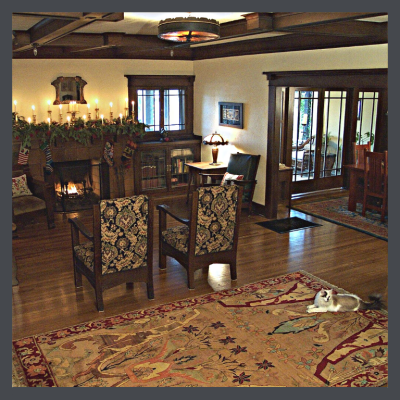 You can’t see me. I am shaking my head. But I am somewhat (It’s a very small picture.) calmed by the image I see of the beautiful box beam ceilings in the living room of the Hare House, my 1920 Craftsman in L.A., on page 56.
You can’t see me. I am shaking my head. But I am somewhat (It’s a very small picture.) calmed by the image I see of the beautiful box beam ceilings in the living room of the Hare House, my 1920 Craftsman in L.A., on page 56.
Jane describes ceiling cracks, their causes & not surprisingly, recommends against covering them with gold-veined mirror tiles. My ceilings in the Hare House were coated with “popcorn.” Yes, even between the box beams in this room & in every other room in the house. It wasn’t terribly difficult to remove, in fact, after we had sprayed a chunky section of the back bedroom ceiling, the whole thing fell down. Whumph! The sound & the dust were like a nuclear explosion. All the popcorn, all the plaster, down to the lathe, it was on the floor in one piece. A cracked piece, for sure, but it was all there. Amazingly, nobody was standing under it.
She devotes a whole page to asbestos & strongly recommends testing. I second.
CHAPTER FIVE: WALL MART
Whoo, boy! This is a chunky chapter so I think I’ll just list what is covered in it, with little commentary.
- Joinery & nails
- Balloon framing
- Brick & stone
- Paint types & colors
- Stencils
- Wallpaper
- Paneling & trim
- Built-ins
- Wood stains & finishes
As always, the book is well-illustrated with beautiful examples of every topic & sub-topic. And, she ends with her sensible obsessive & compromise solutions
CHAPTER SIX: OPENING LINES
The chapter opens with Jane saying, “Bungalow designers did their best to open the houses to the outdoors with generous numbers of windows & doors. The interplay between indoors & out made even a small bungalow larger than it really was. There was also a belief that fresh air & sunshine would kill germs, prevent disease & promote good health.”
She gives us a brief window history lesson, including some information about glass.
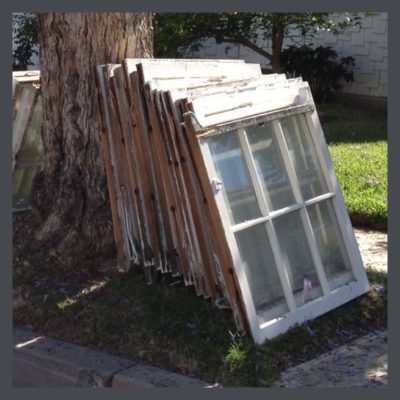 The best part is her dissertation on why replacing wood windows is a travesty. She lays out 4 pages, in tiny type, enumerating all the lie$ that are told to encourage people to rip out their wonderful old windows & install, new, hideous ones that you can replace in 15 years when they fail because they cannot be repaired. In her OBSESSIVE/COMPROMISE section, she says that she refuses to compromise.
The best part is her dissertation on why replacing wood windows is a travesty. She lays out 4 pages, in tiny type, enumerating all the lie$ that are told to encourage people to rip out their wonderful old windows & install, new, hideous ones that you can replace in 15 years when they fail because they cannot be repaired. In her OBSESSIVE/COMPROMISE section, she says that she refuses to compromise.
As I sit here writing, tears are dripping down my face, missing this funny, fierce woman. I have written so much about her, but it is in this section that her firey spirit truly shines. I can only pray that my little blog will help her message live on.
A blow & a sniff later & I’m ready to carry on. She gives complete instructions for repairing a wood window, suggesting tools & materials. Then she treats us to vintage ad images for windows parts & signs off with a section on window treatments.
I offer window suggestions in my own article, here.
CHAPTER SEVEN: ENTRY LEVEL
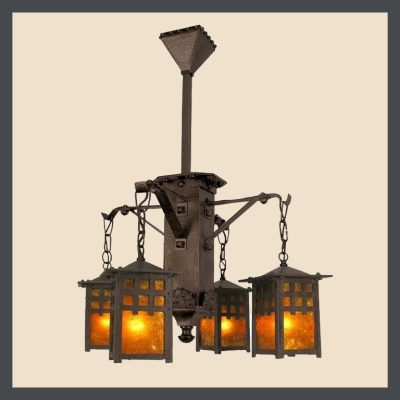 Not surprisingly, this chapter is about doors, types of doors, (interior & exterior) door construction, & door hardware-with the same great photos of beautiful door pulls & knobs & escutcheons. She has a number of cool, vintage ads, including one “For homes of refinement.”
Not surprisingly, this chapter is about doors, types of doors, (interior & exterior) door construction, & door hardware-with the same great photos of beautiful door pulls & knobs & escutcheons. She has a number of cool, vintage ads, including one “For homes of refinement.”
As she says, “The front door was meant to impress,” I have been impressed by more than one front door. I have to admit that the door of the Hare House is my all-time favorite & I was very torn by my choice to build a screen door so that my children could look out onto the world but be protected. (Between the skunks & coyotes, Eagle Rock was not a safe place for kitties.) We found the most figured pieces of quartersaw oak that you could imagine & with my copper screening & pegged joints, I was happy!
She also devotes several pages to lighting, treating us to some terrific examples of Arts & Crafts pendants & sconces.
In her section, CAN DON’T, she is adamant about the inappropriateness of can lighting. Once again, I concur, especially because the lighting of the time is so charming!!
I hope that this wonderful image will help you recover from the last one of the windows, abandoned, like poor relations, under the tree.
CHAPTER EIGHT: HEARTH OF THE MATTER
According to Jane, “Fire fulfills a deep & primal role in the human psyche…” Why else would there be 110 videos on YouTube of crackling fireplaces?
Anyway, we see some amazing fireplaces here- clinker brick, 2-tone brick, river-roof, cast concrete, granite & Grueby & Batchelder tiles. Not surprisingly she spends 14 pages delving into the history & construction of the fireplace.
Next is the subject of built-ins & once more, we are treated to beautiful images of sideboards, nooks, Murphy beds & stairways, plus vintage hardware ads & illustrations.
CHAPTER NINE: SUPPORT GROUP
Jane wraps it up with a discussion of floors, subfloors & joists as well as rugs & vacuum cleaners to keep all the dirt sucked up. She talks about furnaces & heating systems & we see some ads for new fangled contraptions that will keep you toasty. She shows us some really cool old water heaters & waxes enthusiastic about fuse boxes & electrical receptacles.
Last Call is about telephones with her closing statement being, “Besides, a bungalow is the best house in the world.”
READ ALL JANE’S BOOKS ABOUT BUNGALOWS!
 BUNGALOW KITCHENS
BUNGALOW KITCHENS
Restoring the heart of the home.
 BUNGALOW BATHROOMS
BUNGALOW BATHROOMS
Everything you need to know to restore or create a beautiful & functional bungalow bathroom.
 BUNGALOW DETAILS: EXTERIOR
BUNGALOW DETAILS: EXTERIOR
What makes a bungalow.
 BUNGALOW: THE ULTIMATE ARTS & CRAFTS HOME
BUNGALOW: THE ULTIMATE ARTS & CRAFTS HOME
All things bungalow.
& last but not least
 LINOLEUM
LINOLEUM
It’s not vinyl!

STAY IN THE BUNGALOW KNOW!!!
Sign up for our newsletter & receive our FREE E-book, 7 VITAL Things to Do Before You Hire a Contractor.

 What is interior design? It is a combination of art, science & technology that is employed to enhance the quality of our lives. It is also about understanding how people operate in a space in order to make it functional. In this article, we’re going to look at the elements of basic design for a Craftsman house interior
What is interior design? It is a combination of art, science & technology that is employed to enhance the quality of our lives. It is also about understanding how people operate in a space in order to make it functional. In this article, we’re going to look at the elements of basic design for a Craftsman house interior Negative space is the area around & between objects, what we usually think of when we say space. It allows our eyes to pause & to see objects individually. With the use of negative space, the eye gets a rest.
Negative space is the area around & between objects, what we usually think of when we say space. It allows our eyes to pause & to see objects individually. With the use of negative space, the eye gets a rest.
 Positive space is the areas defined by objects- architectural details, furniture, textiles, artwork, lighting. The areas are where you want to direct the eye. Which objects you choose & how you place them will determine how the space will feel. Here you can employ all the rest of the elements- form, color, light & texture- to create a mood, tell your story, & enhance the existing features of your bungalow, as well as creating a space that will serve you & your family well.
Positive space is the areas defined by objects- architectural details, furniture, textiles, artwork, lighting. The areas are where you want to direct the eye. Which objects you choose & how you place them will determine how the space will feel. Here you can employ all the rest of the elements- form, color, light & texture- to create a mood, tell your story, & enhance the existing features of your bungalow, as well as creating a space that will serve you & your family well. Using the correct balance of positive & negative space will help you achieve the look that you want. Like the yin & yang of ancient Chinese philosophy, positive & negative spaces are opposite but complement or complete one another & interrelate to form a whole.
Using the correct balance of positive & negative space will help you achieve the look that you want. Like the yin & yang of ancient Chinese philosophy, positive & negative spaces are opposite but complement or complete one another & interrelate to form a whole. Light is a vital aspect of any space. A key characteristic of bungalows is that they tend to be on the dark side. Their shady porches & deep overhangs made them bearable before air-conditioning & their dark wood can feel oppressive prompting people to pull out the paintbrush. (Put it down, please.) Once against, contrast creates interest here & the correct use of color & lighting will make your house more livable & lovely.
Light is a vital aspect of any space. A key characteristic of bungalows is that they tend to be on the dark side. Their shady porches & deep overhangs made them bearable before air-conditioning & their dark wood can feel oppressive prompting people to pull out the paintbrush. (Put it down, please.) Once against, contrast creates interest here & the correct use of color & lighting will make your house more livable & lovely. STAY IN THE BUNGALOW KNOW!!!
STAY IN THE BUNGALOW KNOW!!!


 INTERIOR DESIGN FOR A CRAFTSMAN HOUSE -More Elements
INTERIOR DESIGN FOR A CRAFTSMAN HOUSE -More Elements
 Dynamic lines create a feeling of energy & movement. These lines are found most often in the arts & crafts of the Movement, in the portrayal of nature. Pottery, textiles & metalwork feature provide a flowing contrast to the often bulky feel of furniture typical to the period. The juxtaposition of these elements with the horizontal lines of the furniture create interest in a room.
Dynamic lines create a feeling of energy & movement. These lines are found most often in the arts & crafts of the Movement, in the portrayal of nature. Pottery, textiles & metalwork feature provide a flowing contrast to the often bulky feel of furniture typical to the period. The juxtaposition of these elements with the horizontal lines of the furniture create interest in a room.
 A home is an intimate space & tactile sensation, interpreted through the skin & the eyes is a key element in design.
A home is an intimate space & tactile sensation, interpreted through the skin & the eyes is a key element in design. Colors are very powerful in setting tone & influencing mood in the interior design for a Craftsman house. You spend a great deal of time in your home & I think that you might need to review
Colors are very powerful in setting tone & influencing mood in the interior design for a Craftsman house. You spend a great deal of time in your home & I think that you might need to review 
 My art training consisted of growing up in museums, exposing me to beautiful objects, exquisitely displayed, ballet with its delightful costumery & stage sets, the arts & crafts of the native Americans of the southwest, & the example set by my mother, who had impeccable taste. From a young age, I appreciated beauty but I never had an aptitude for drawing or painting so I never studied art. My taste was formed by what I saw & what my mother taught me. I grew up learning how to decorate in Craftsman style just by osmosis & later, my bungalows were much admired, with 2 of them being featured in books & magazines & on home tours.
My art training consisted of growing up in museums, exposing me to beautiful objects, exquisitely displayed, ballet with its delightful costumery & stage sets, the arts & crafts of the native Americans of the southwest, & the example set by my mother, who had impeccable taste. From a young age, I appreciated beauty but I never had an aptitude for drawing or painting so I never studied art. My taste was formed by what I saw & what my mother taught me. I grew up learning how to decorate in Craftsman style just by osmosis & later, my bungalows were much admired, with 2 of them being featured in books & magazines & on home tours. These words of Irene Sergent, in the Craftsman magazine, express the unifying message, the unifying theme, of the American Arts & Crafts Movement in interior design,
These words of Irene Sergent, in the Craftsman magazine, express the unifying message, the unifying theme, of the American Arts & Crafts Movement in interior design,
 I’m a fan of textiles & encourage the use of simple or low contrast patterns in a smaller bungalow, or room. The Arts & Crafts palette tends to be more muted so it’s a good choice for a house with a reduced square footage, but I still recommend using a more restrained hand in a mini-bungalow. This William Morris pattern, with its muted, pale colors will create a feeling of softness rather than harshly stopping the eye, & would be a good addition to the decor of a smaller space.
I’m a fan of textiles & encourage the use of simple or low contrast patterns in a smaller bungalow, or room. The Arts & Crafts palette tends to be more muted so it’s a good choice for a house with a reduced square footage, but I still recommend using a more restrained hand in a mini-bungalow. This William Morris pattern, with its muted, pale colors will create a feeling of softness rather than harshly stopping the eye, & would be a good addition to the decor of a smaller space.


 We have come to the second lesson about the principles of creating visual harmony in design. The elements of design are the puzzle pieces of design & the way that you fit them together, to decorate in the Craftsman style, is found in the principles. These bungalow style interior design tips are the basics of all good design & if applied, will assist you in creating the home that you want. Perhaps you will never have a Stickley dining room like the one at the American Arts & Crafts Museum in St. Petersburg, Florida, but by learning about Arts & Crafts design you will become more confident & satisfied in putting together your home.
We have come to the second lesson about the principles of creating visual harmony in design. The elements of design are the puzzle pieces of design & the way that you fit them together, to decorate in the Craftsman style, is found in the principles. These bungalow style interior design tips are the basics of all good design & if applied, will assist you in creating the home that you want. Perhaps you will never have a Stickley dining room like the one at the American Arts & Crafts Museum in St. Petersburg, Florida, but by learning about Arts & Crafts design you will become more confident & satisfied in putting together your home. Here we come to the concept of visual weight. Visual weight refers to the degree to which an object draws the eye, which is determined by its size, color and shape. You walk into a room & there’s a mouse & an elephant. Your attention immediately goes to the elephant because of its enormous size. You see 2 squares & one is pale blue & the other bright red. Your attention is instantly on the red. Objects with a regular shape, such as a square or a circle, appear heavier than objects with an irregular shape, such as a paisley, a tear-drop shape with a curled end. The irregularity gives the impression that mass or weight has been removed from a regular shape.
Here we come to the concept of visual weight. Visual weight refers to the degree to which an object draws the eye, which is determined by its size, color and shape. You walk into a room & there’s a mouse & an elephant. Your attention immediately goes to the elephant because of its enormous size. You see 2 squares & one is pale blue & the other bright red. Your attention is instantly on the red. Objects with a regular shape, such as a square or a circle, appear heavier than objects with an irregular shape, such as a paisley, a tear-drop shape with a curled end. The irregularity gives the impression that mass or weight has been removed from a regular shape. Symmetry is achieved by positioning items evenly along a central axis. It creates a sense of stability, calmness & formality. Mimicking nature- leaves, snowflakes, bodies- this type of balance is often used in A&C design. A good example of this is William Morris’ designs.
Symmetry is achieved by positioning items evenly along a central axis. It creates a sense of stability, calmness & formality. Mimicking nature- leaves, snowflakes, bodies- this type of balance is often used in A&C design. A good example of this is William Morris’ designs. Asymmetry is achieved by positioning an uneven number of things along the central axis. The feeling created by this is more modern, with a greater sense of motion.
Asymmetry is achieved by positioning an uneven number of things along the central axis. The feeling created by this is more modern, with a greater sense of motion.
 This leads us to contrast, sudden breaks in the rhythm. Linen curtains against the dark of the window frame, pillows on the dark upholstery, creamy slag glass in the lamps on the tables, even the glow of the logs burning in the fireplace, below the dark mantel form a contrast against your dark wood trim.
This leads us to contrast, sudden breaks in the rhythm. Linen curtains against the dark of the window frame, pillows on the dark upholstery, creamy slag glass in the lamps on the tables, even the glow of the logs burning in the fireplace, below the dark mantel form a contrast against your dark wood trim.


 Here you are in your empty house. It echoes. It promises. It suggests. It perplexes.
Here you are in your empty house. It echoes. It promises. It suggests. It perplexes. 1. Create an overhead scale model of the room or rooms if your bungalow’s dining room is joined to the living room. (Probably.)
1. Create an overhead scale model of the room or rooms if your bungalow’s dining room is joined to the living room. (Probably.) 2. Take the measurements of each piece of furniture that will come with you. Include all dimensions & insert them to scale.You can do more than one rendition of this image, fooling around with different pieces. Some of the items that you will bring are not forever pieces. Spaces evolve as you decorate your bungalow.
2. Take the measurements of each piece of furniture that will come with you. Include all dimensions & insert them to scale.You can do more than one rendition of this image, fooling around with different pieces. Some of the items that you will bring are not forever pieces. Spaces evolve as you decorate your bungalow. 3. So here are the final, fully furnished rooms. It took me a long time to find the perfect couch & chairs because the room was so large & I am never in favor of using a large number of pieces. I needed comfortable ones that were appropriate in the scale of the room, to which I could add my bamboo folding chairs when I was expecting a houseful of people. (Part
3. So here are the final, fully furnished rooms. It took me a long time to find the perfect couch & chairs because the room was so large & I am never in favor of using a large number of pieces. I needed comfortable ones that were appropriate in the scale of the room, to which I could add my bamboo folding chairs when I was expecting a houseful of people. (Part 
 In BUNGALOW
In BUNGALOW You can’t see me. I am shaking my head. But I am somewhat (It’s a very small picture.) calmed by the image I see of the beautiful box beam ceilings in the living room of the
You can’t see me. I am shaking my head. But I am somewhat (It’s a very small picture.) calmed by the image I see of the beautiful box beam ceilings in the living room of the  The best part is her dissertation on why replacing wood windows is a travesty. She lays out 4 pages, in tiny type, enumerating all the lie$ that are told to encourage people to rip out their wonderful old windows & install, new, hideous ones that you can replace in 15 years when they fail because they cannot be repaired. In her OBSESSIVE/COMPROMISE section, she says that she refuses to compromise.
The best part is her dissertation on why replacing wood windows is a travesty. She lays out 4 pages, in tiny type, enumerating all the lie$ that are told to encourage people to rip out their wonderful old windows & install, new, hideous ones that you can replace in 15 years when they fail because they cannot be repaired. In her OBSESSIVE/COMPROMISE section, she says that she refuses to compromise. Not surprisingly, this chapter is about doors, types of doors, (interior & exterior) door construction, & door hardware-with the same great photos of beautiful door pulls & knobs & escutcheons. She has a number of cool, vintage ads, including one “For homes of refinement.”
Not surprisingly, this chapter is about doors, types of doors, (interior & exterior) door construction, & door hardware-with the same great photos of beautiful door pulls & knobs & escutcheons. She has a number of cool, vintage ads, including one “For homes of refinement.”